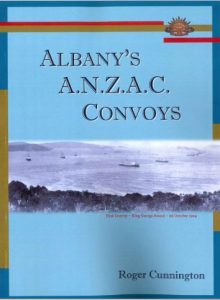- Author
- Book reviewer
- Subjects
- History - WW1, Book reviews, Naval Engagements, Operations and Capabilities
- Tags
-
- RAN Ships
- None noted.
- Publication
- September 2014 edition of the Naval Historical Review (all rights reserved)
Albany’s ANZAC Convoys by Roger Cunnington. Published by Digger Press, Albany, WA, 2014. Paperback of 176 pages with b&w illustrations, maps and diagrams. $46.95, from sales@diggerpress.com or albanyconvoys@westnet.com.au.

The release of this publication is well timed with the centenary of the commencement of WW I and reminds us of the immense organisation involved in assembling armed assistance by the dominions in response to the call of the mother country. Roger Cunnington, who is a maritime researcher with the Albany Historical Society, has assembled an impressive amount of material concisely into one volume which is easily referenced. The acronym ‘ANZAC’ in the title of the book was not used until shortly before the second convoy gathered in King George Sound but the author has used it because of its association with both the Australian Imperial Force (AIF) and the New Zealand Expeditionary Force (NZEF).
This book tells the story of the first two convoys that took soldiers of the AIF and the NZEF to the battlefields during WW I, departing from the Port of Albany in Western Australia in the latter part of 1914, within a couple of months of one another. All of the Australian troops who departed from Albany were embarked in the eastern states. Those home grown soldiers from Western Australia left from Fremantle a day later to meet up with their counterparts off the Western Australian coast.
While much has been published about the actual battlefield experiences of soldiers of WW I, very little has been produced about the day-to-day life of the men between boarding their ships in Australia and New Zealand and leaving them many weeks and sometimes months later in Egypt. The author has researched soldiers’ personal letters, diaries, official diaries from the Australian War Memorial, national and state archives, unit histories, the Port of Albany Register of Inwards Shipping Movements and of course relevant volumes of Bean’s and Jose’s official war histories.
The enormous amount of logistical support required to provide provisions for such a large fleet in readiness for war is explained. These were the two largest transport contingents to depart from Australasia and both assembled and departed from King George Sound. The First Convoy which departed on 1 November 1914 comprised 28 Australian and 10 New Zealand transports with nearly 30,000 men and over 11,700 horses. Before these ships could return to Australia a second contingent of troops was ready to be sent overseas. It was therefore necessary to requisition another convoy of sixteen Australian and three New Zealand transport ships which again assembled at King George Sound and mostly departed on 31 December 1914 with in excess of 12,000 men and over 5,000 horses. Because of the unknown presence of the German East Asiatic Squadron the First Convoy was heavily protected by HMS Minotaur and HMA Ships Melbourne and Sydney, later joined by the Japanese cruiser HIJMS Ibuki. With the enemy presence largely dissipated with the demise of SMS Emden by Sydney, the Second Convoy was only protected by several of the larger transport ships which had been modified to be Defensively Armed Merchant Ships. HMAT Berrima towed the Submarine AE2 for most of the voyage.
We are offered detailed descriptions of life on board the vessels for both the soldiers and their horses, as well as the more formal descriptions of the planning and preparations for the convoys, including the ships’ acquisitions and fitting out. Scattered throughout the text are several black and white photographs which reveal quite vividly the conditions that would have been accepted as normal in wartime conditions of the day but which today’s soldiers would no doubt, consider primitive. Further description is provided of Albany’s wartime troop and hospital ship replenishment role which would have been of particular importance for the two convoys which were the two largest transport contingents to depart from Australasia and the only ones to depart from Albany.
The volume comes complete with a detailed bibliography and index. There is a plentiful supply of appendices which includes a brief history of each of the Australian and New Zealand ships in the first and second convoys.
This book is highly recommended to those readers who, having read other works detailing life in the trenches for the soldiers of WW I, would like to learn how they arrived and more about their lives from a slightly different perspective.
Reviewed by Liz Colthorpe




